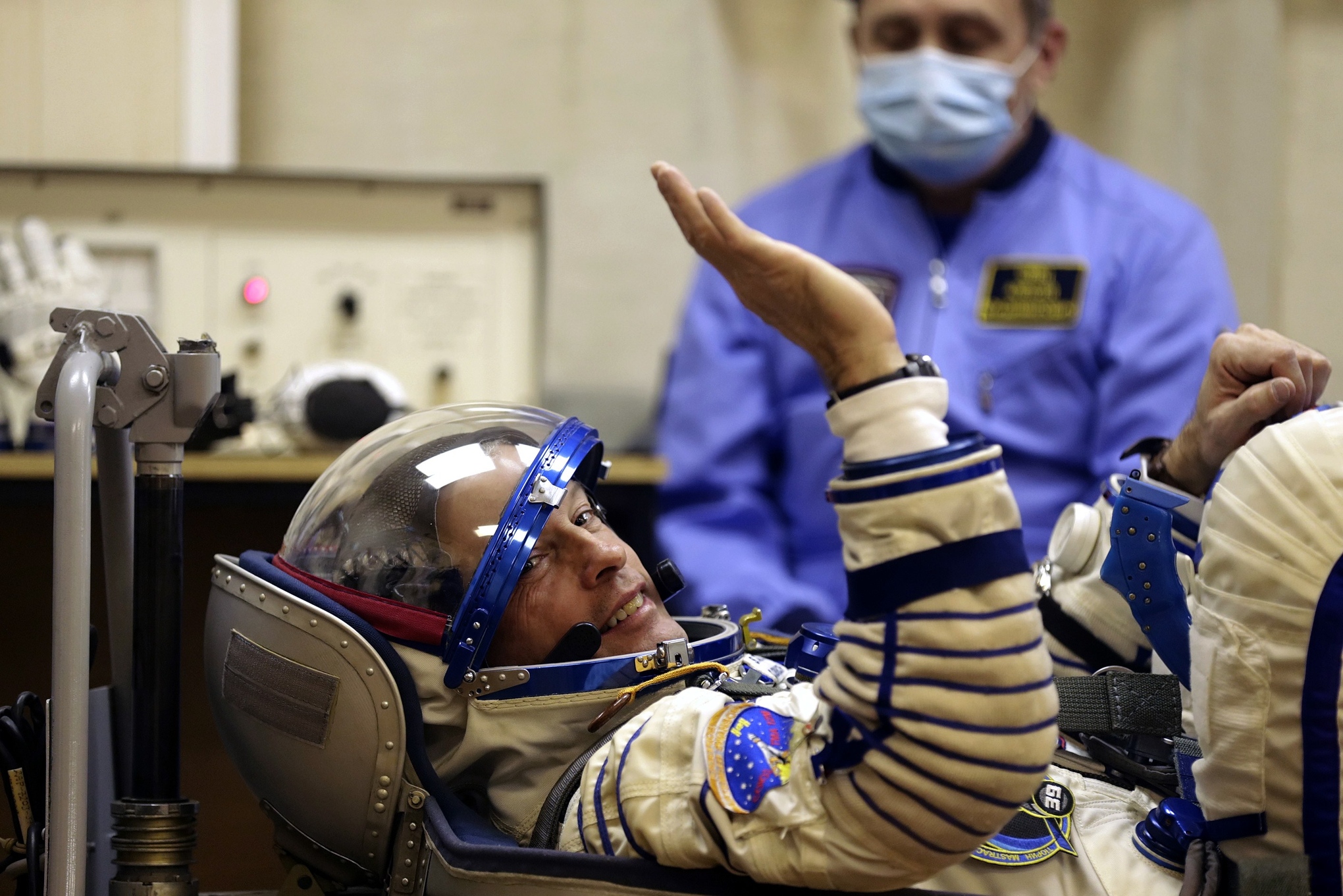- Joined
- Nov 29, 2016
- Messages
- 5,674
- Points
- 63
The US portion of ISS DOES NOT HAVE ANY PROPULSION meaning when detached from the Russian portion - where propulsion is, NASA portion will fall off like an uncontrollable space junk! Crashing on to earth! MAGA!
https://www.inverse.com/article/16077-russia-will-not-send-u-s-astronauts-to-iss-after-2018
Russia Will Not Send U.S. Astronauts to ISS After 2018
NASA has few other options for sending people to the space station.
By Neel V. Patel on May 24, 2016
Russia will not conduct any more space launches to send U.S. astronauts to the International Space Station after 2018, according to a release issued by the country’s TASS news agency.
“We are working with our partners under the effective contracts, but we have no plans for concluding new ones,” Sergey Saveliev, the deputy chief of Russia’s state-run space agency Roscosmos, told TASS.
Without question, Russian-American relations are at an all time low since the end of the Cold War. One of the brighter points to this conflict has been the fact that NASA and Roscomos have continued to get along with their collaborative projects and missions in relative peace. Since the shuttering of the Space Shuttle program in 2011, the U.S. has relied exclusively on sending its astronauts to the ISS aboard Russian Soyuz spacecraft launches.
Unfortunately, this has put the United States at the mercy of Russia in the event any kind of conflict would arise. “We’re in a hostage situation,” former NASA administrator Michael Griffin once told ABC News. “Russia can decide that no more U.S. astronauts will launch to the International Space Station, and that’s not a position that I want our nation to be in.”
The situation hit a nadir when Russian Deputy Prime Minister Dmitry Rogozin tweeted in 2014:
Article continues below
Get stories that spark curiosity sent straight to your inbox.
Sign up for our newsletter:
“After analyzing the sanctions against our space industry, I suggest to the USA to bring their astronauts to the International Space Station using a trampoline.”
It seems Russia is now making good on subtle threats in the last few years to end their space relationship with the U.S.
The big question now is how will the United States continue to send astronauts to the ISS after 2018? Well, that year coincides with the test launch of NASA’s new Space Launch System. The goal of SLS is to launch rockets that can deliver spacecraft to places beyond Earth’s orbit, but there’s no reason to think it can’t also be used to send people to the ISS.
That just leaves the question of what kind of spacecraft will be delivering people to the station itself. NASA’s successor space vehicle to the shuttle Orion won’t be ready for crewed mission until 2023.
The agency instead may have to rely on private companies for such vehicles. Two of the most promising options are Boeing’s CST-100 Starliner, which will hopefully conduct a manned launch in 2018, and the SpaceX Dragon Capsule, which will be conducting crewed tests just next year.
NASA has no qualms with working with private companies to fulfill its missions — especially American ones. The agency has enthusiastically worked with SpaceX and others to conduct ISS resupply missions for the last couple of years, allowing those companies to stretch their space legs and become more experienced with advancing their launch operations and technologies.
That’s critical, because the lack of experience on the part of those countries has reared its ugly head time and time again. After all, there have been multiple ISS resupply missions that have resulted in explosive failure — literally.
If NASA’s only recourse for sending astronauts to the ISS after 2018 are Elon Musk and others, they had better ensure those companies can guarantee the safety of those men and women aboard those spacecraft as well as Russia could with the Soyuz missions. Right now, it’s too early to say they can.
Love space? Listen to the latest episode of our new podcast: I Need My Space
https://www.popularmechanics.com/space/moon-mars/a19159719/roscosmos-china-collaboration/
Russia's Space Agency Might Break Up With the U.S. To Get With China
After almost three decades of cooperation, Roscosmos is now eyeing a future in space with China.

By Anatoly Zak
Mar 8, 2018
379

Getty ImagesVCG
Last month Russia’s space agency, Roscosmos State Corporation, began work on a contingency plan that would reshape its future in space exploration. The country could shift its human spaceflight cooperation from the U.S. to China, sources within Roscosmos told Popular Mechanics. One possible scenario includes Roscosmos exiting the International Space Station program early.
Russian experts were instructed to put forward ideas by March 15, including concepts for potential contributions to the planned Chinese space station along with a joint Russian-Chinese plans to send humans to the Moon.
A Historic Relationship
If adopted, the new strategy would mark a historic moment for the Russian space program, which has cooperated with the U.S. for nearly three decades. In 1993, not long after the breakup of the USS, the Russian and American human spaceflight programs (along with Europe, Canada, and Japan) joined together to build the ISS. Lately, though, worsening relations between Moscow and Washington have prompted Roscosmos to seek its own way in space, which could happen before or after the ISS’s current expiration date some time between 2024 and 2028.
For a number of years, the Kremlin considered building an independent program for human spaceflight with plans ranging from a relatively modest space station in the Earth’s orbit to ambitious proposals to build a permanent base on the Moon. But under current economic strains, the Russian government needed an international partner—at least for the time being.
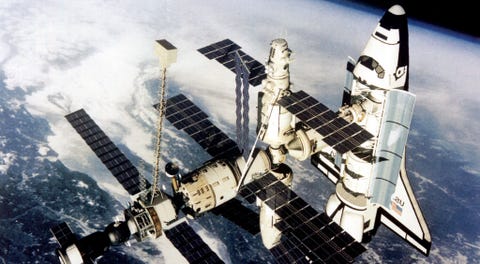
Space Shuttle Atlantis docking with the Mir space station in 1995.
Getty ImagesSovfoto/UIG
Last summer, Moscow reluctantly agreed to join NASA-led studies of a habitable outpost in orbit around the Moon that would succeed the ISS in mid-2020s. While the near-lunar station remains on the drawing board even as U.S.-Russian relations sour, Roscosmos decided to look at the alternatives. At the end of February, the corporation instructed its strategists to evaluate cooperation with China by supplying Russian hardware for the Chinese space station.
In 2020, Beijing plans to launch the first piece of its new multi-modular outpost similar to the Russian Mir space station. For a number of years, Chinese space officials have been inviting other space powers to contribute to the planned orbital base, but the response was lukewarm due to financial and political concerns. Now there are signs that the situation might be slowly turning to China’s favor. Besides Russia, the European Space Agency, ESA, and Japan are now reportedly re-examining their participation in the Chinese space station project.
A Mismatch Made in Space
In June 2017, Roscosmos head Igor Komarov said that Russia had been invited to participate in the Chinese space station but admitted to a mismatch in plans. Russian engineers first considered the country’s active involvement in the Chinese space station in 2015, but at the time, Roscosmos hoped that China would assemble its outpost in the orbit easily accessible from Baikonur Cosmodrome, which Russia rents from Kazakhstan.
Since then, China informed its potential contributors that the station would be inserted into an orbit inclined between 41 and 43 degrees toward the Equator. Baikonur is situated at a latitude of 46 degrees, which means that the Russian missions heading to the Chinese space station would have to conduct propellant-hungry maneuvers to reduce their orbital inclination.

Sea Launch Ocean Odyssey platform, 2009.
Wikimedia Commonsjurvetson
One partial solution to this orbital mismatch between Russia and China would be the Sea Launch platform. The Russian-owned, California-based floating launch pad offers flexibility in accessing various orbits thanks to its ability to sail to the most convenient launch position. A Russian private company is currently working on reactivating the Sea Launch after a long hiatus.
Sea Launch would currently only launch robotic cargo vehicles and space station modules, leaving open the issue of delivering Russian cosmonauts to the Chinese space station. According to industry sources, Roscosmos was unlikely to agree for its cosmonauts to hitchhike to the station aboard the Chinese Shenzhou vehicles, as China proposed, without having full access to the station with its own passenger spacecraft.
To the Moon and Back
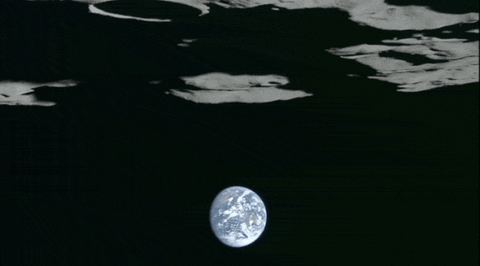

Jaxa
On Saturday, Roskosmos and China National Space Administration, CNSA, signed a memorandum of intentions on possible joint effort in the exploration of the Moon with robotic probes.
Russia considers yet-to-be-launched automated lunar landers as precursors for the future habitable lunar base which would be built in the polar regions of the Moon. China also tabled preliminary plans to send expeditions to the Moon after finishing the assembly of its space station. Russia and China could see their goals in space converge if the U.S. fails to fully draw in one of these two countries into its own orbit.
The latest Russian overtures to China are in very early stages and might not result in any actual change in policy. The U.S. also wouldn't be completely left out in the cold, but would be forced to consider commercial spaceflight options, like SpaceX or United Launch Alliance. But the mere fact that such an option is on the table at Roscosmos’ headquarters is a huge deal, and the final decision, whatever it might be, could have long-running implications for the future of human space flight in all three countries.
https://www.inverse.com/article/16077-russia-will-not-send-u-s-astronauts-to-iss-after-2018
Russia Will Not Send U.S. Astronauts to ISS After 2018
NASA has few other options for sending people to the space station.
By Neel V. Patel on May 24, 2016
Russia will not conduct any more space launches to send U.S. astronauts to the International Space Station after 2018, according to a release issued by the country’s TASS news agency.
“We are working with our partners under the effective contracts, but we have no plans for concluding new ones,” Sergey Saveliev, the deputy chief of Russia’s state-run space agency Roscosmos, told TASS.
Without question, Russian-American relations are at an all time low since the end of the Cold War. One of the brighter points to this conflict has been the fact that NASA and Roscomos have continued to get along with their collaborative projects and missions in relative peace. Since the shuttering of the Space Shuttle program in 2011, the U.S. has relied exclusively on sending its astronauts to the ISS aboard Russian Soyuz spacecraft launches.
Unfortunately, this has put the United States at the mercy of Russia in the event any kind of conflict would arise. “We’re in a hostage situation,” former NASA administrator Michael Griffin once told ABC News. “Russia can decide that no more U.S. astronauts will launch to the International Space Station, and that’s not a position that I want our nation to be in.”
The situation hit a nadir when Russian Deputy Prime Minister Dmitry Rogozin tweeted in 2014:
Article continues below
Get stories that spark curiosity sent straight to your inbox.
Sign up for our newsletter:
“After analyzing the sanctions against our space industry, I suggest to the USA to bring their astronauts to the International Space Station using a trampoline.”
It seems Russia is now making good on subtle threats in the last few years to end their space relationship with the U.S.
The big question now is how will the United States continue to send astronauts to the ISS after 2018? Well, that year coincides with the test launch of NASA’s new Space Launch System. The goal of SLS is to launch rockets that can deliver spacecraft to places beyond Earth’s orbit, but there’s no reason to think it can’t also be used to send people to the ISS.
That just leaves the question of what kind of spacecraft will be delivering people to the station itself. NASA’s successor space vehicle to the shuttle Orion won’t be ready for crewed mission until 2023.
The agency instead may have to rely on private companies for such vehicles. Two of the most promising options are Boeing’s CST-100 Starliner, which will hopefully conduct a manned launch in 2018, and the SpaceX Dragon Capsule, which will be conducting crewed tests just next year.
NASA has no qualms with working with private companies to fulfill its missions — especially American ones. The agency has enthusiastically worked with SpaceX and others to conduct ISS resupply missions for the last couple of years, allowing those companies to stretch their space legs and become more experienced with advancing their launch operations and technologies.
That’s critical, because the lack of experience on the part of those countries has reared its ugly head time and time again. After all, there have been multiple ISS resupply missions that have resulted in explosive failure — literally.
If NASA’s only recourse for sending astronauts to the ISS after 2018 are Elon Musk and others, they had better ensure those companies can guarantee the safety of those men and women aboard those spacecraft as well as Russia could with the Soyuz missions. Right now, it’s too early to say they can.
Love space? Listen to the latest episode of our new podcast: I Need My Space
https://www.popularmechanics.com/space/moon-mars/a19159719/roscosmos-china-collaboration/
Russia's Space Agency Might Break Up With the U.S. To Get With China
After almost three decades of cooperation, Roscosmos is now eyeing a future in space with China.

By Anatoly Zak
Mar 8, 2018
379

Getty ImagesVCG
Last month Russia’s space agency, Roscosmos State Corporation, began work on a contingency plan that would reshape its future in space exploration. The country could shift its human spaceflight cooperation from the U.S. to China, sources within Roscosmos told Popular Mechanics. One possible scenario includes Roscosmos exiting the International Space Station program early.
Russian experts were instructed to put forward ideas by March 15, including concepts for potential contributions to the planned Chinese space station along with a joint Russian-Chinese plans to send humans to the Moon.
A Historic Relationship
If adopted, the new strategy would mark a historic moment for the Russian space program, which has cooperated with the U.S. for nearly three decades. In 1993, not long after the breakup of the USS, the Russian and American human spaceflight programs (along with Europe, Canada, and Japan) joined together to build the ISS. Lately, though, worsening relations between Moscow and Washington have prompted Roscosmos to seek its own way in space, which could happen before or after the ISS’s current expiration date some time between 2024 and 2028.
For a number of years, the Kremlin considered building an independent program for human spaceflight with plans ranging from a relatively modest space station in the Earth’s orbit to ambitious proposals to build a permanent base on the Moon. But under current economic strains, the Russian government needed an international partner—at least for the time being.

Space Shuttle Atlantis docking with the Mir space station in 1995.
Getty ImagesSovfoto/UIG
Last summer, Moscow reluctantly agreed to join NASA-led studies of a habitable outpost in orbit around the Moon that would succeed the ISS in mid-2020s. While the near-lunar station remains on the drawing board even as U.S.-Russian relations sour, Roscosmos decided to look at the alternatives. At the end of February, the corporation instructed its strategists to evaluate cooperation with China by supplying Russian hardware for the Chinese space station.
In 2020, Beijing plans to launch the first piece of its new multi-modular outpost similar to the Russian Mir space station. For a number of years, Chinese space officials have been inviting other space powers to contribute to the planned orbital base, but the response was lukewarm due to financial and political concerns. Now there are signs that the situation might be slowly turning to China’s favor. Besides Russia, the European Space Agency, ESA, and Japan are now reportedly re-examining their participation in the Chinese space station project.
A Mismatch Made in Space
In June 2017, Roscosmos head Igor Komarov said that Russia had been invited to participate in the Chinese space station but admitted to a mismatch in plans. Russian engineers first considered the country’s active involvement in the Chinese space station in 2015, but at the time, Roscosmos hoped that China would assemble its outpost in the orbit easily accessible from Baikonur Cosmodrome, which Russia rents from Kazakhstan.
Since then, China informed its potential contributors that the station would be inserted into an orbit inclined between 41 and 43 degrees toward the Equator. Baikonur is situated at a latitude of 46 degrees, which means that the Russian missions heading to the Chinese space station would have to conduct propellant-hungry maneuvers to reduce their orbital inclination.

Sea Launch Ocean Odyssey platform, 2009.
Wikimedia Commonsjurvetson
One partial solution to this orbital mismatch between Russia and China would be the Sea Launch platform. The Russian-owned, California-based floating launch pad offers flexibility in accessing various orbits thanks to its ability to sail to the most convenient launch position. A Russian private company is currently working on reactivating the Sea Launch after a long hiatus.
Sea Launch would currently only launch robotic cargo vehicles and space station modules, leaving open the issue of delivering Russian cosmonauts to the Chinese space station. According to industry sources, Roscosmos was unlikely to agree for its cosmonauts to hitchhike to the station aboard the Chinese Shenzhou vehicles, as China proposed, without having full access to the station with its own passenger spacecraft.
To the Moon and Back


Jaxa
On Saturday, Roskosmos and China National Space Administration, CNSA, signed a memorandum of intentions on possible joint effort in the exploration of the Moon with robotic probes.
Russia considers yet-to-be-launched automated lunar landers as precursors for the future habitable lunar base which would be built in the polar regions of the Moon. China also tabled preliminary plans to send expeditions to the Moon after finishing the assembly of its space station. Russia and China could see their goals in space converge if the U.S. fails to fully draw in one of these two countries into its own orbit.
The latest Russian overtures to China are in very early stages and might not result in any actual change in policy. The U.S. also wouldn't be completely left out in the cold, but would be forced to consider commercial spaceflight options, like SpaceX or United Launch Alliance. But the mere fact that such an option is on the table at Roscosmos’ headquarters is a huge deal, and the final decision, whatever it might be, could have long-running implications for the future of human space flight in all three countries.






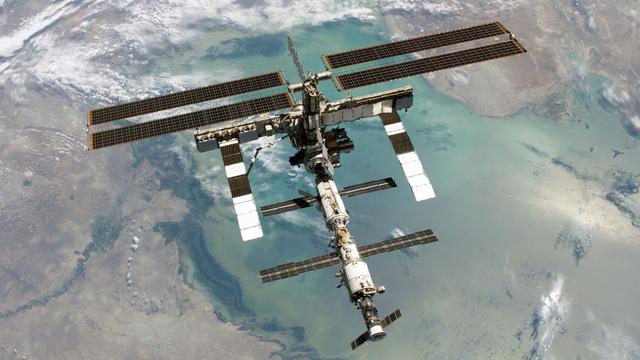
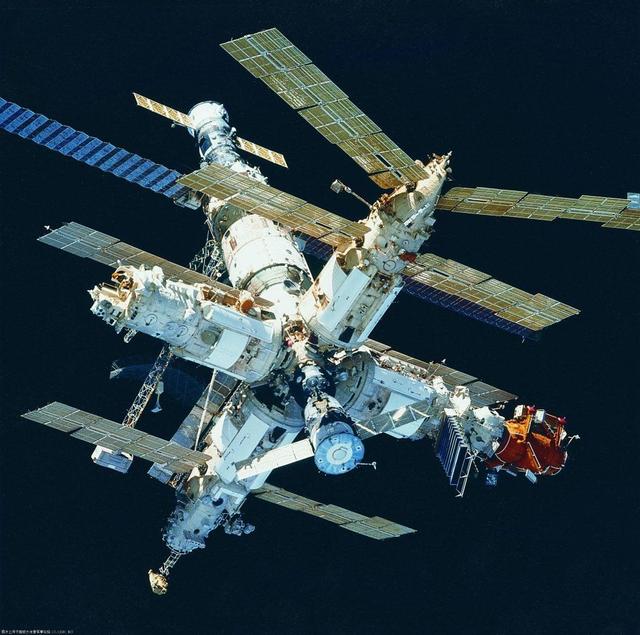





/cdn.vox-cdn.com/uploads/chorus_image/image/32996161/166386798.0.jpg)


